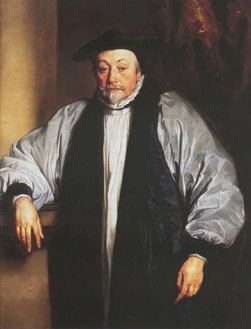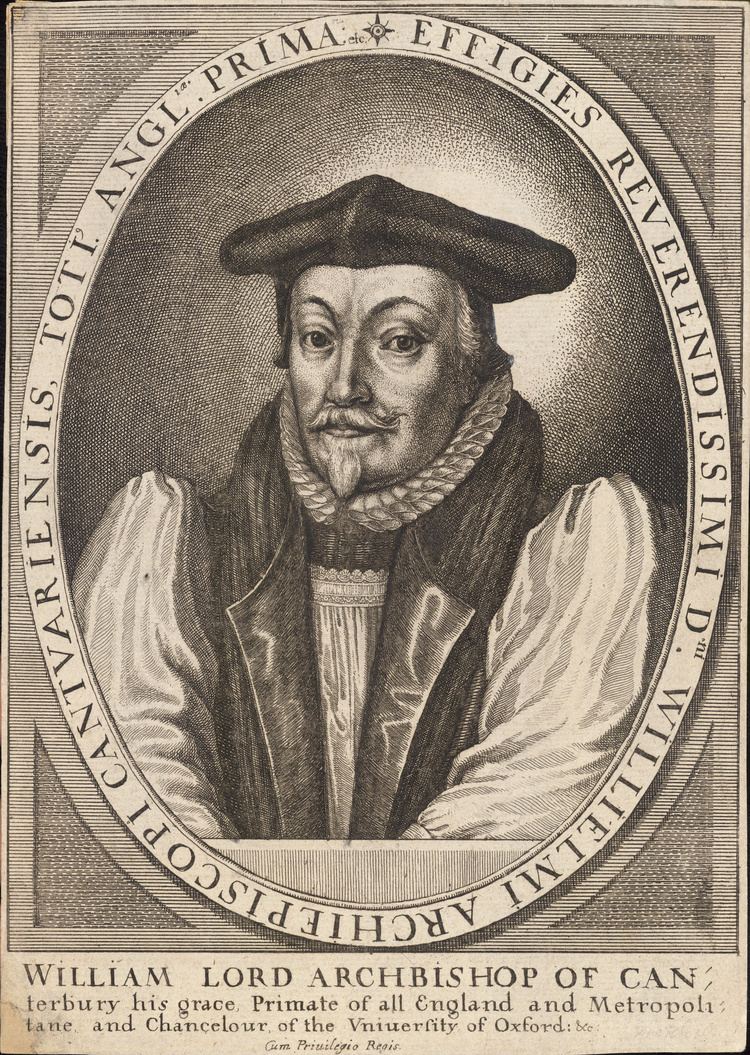Installed 1633 Name William Laud Parents William Laud, Lucy Webbe Feast day 10 January | Signature | |
 | ||
Born 7 October 1573Reading, Berkshire ( 1573-10-07 ) Books Articles Exhibited Against William, Archbishop of Canterbury Similar People Charles I of England, Thomas Wentworth - 1st Earl of, James VI and I, James Ussher, Jacobus Arminius | ||
William laud quotes
William Laud (7 October 1573 – 10 January 1645) was an English archbishop and academic. He was Archbishop of Canterbury from 1633, during the personal rule of Charles I. Arrested in 1640, he was executed in 1645.
Contents
- William laud quotes
- William Laud
- Early life
- Under James I
- 1625 to 1628
- Bishop of London and Thorough
- Archbishop of Canterbury
- Trial and execution
- Legacy
- References
In matters of church polity, Laud was autocratic. Laudianism refers to a collection of rules on matters of ritual, in particular, that were enforced by Laud in order to maintain uniform worship in England and Wales, in line with the king's preferences. They were precursors to later High Church views. In theology, Laud was accused of being an Arminian and opponent of Calvinism, as well as covertly favouring Roman Catholic doctrines (see Arminianism in the Church of England). On all three grounds, he was regarded by Puritan clerics and laymen as a formidable and dangerous opponent.

Laud favoured scholars, and was a major collector of manuscripts. He pursued ecumenical contacts with the Greek Orthodox Church.

The pun "give great praise to the Lord, and little Laud to the devil" is a warning to King Charles attributed to Archibald Armstrong, the official court jester. Laud was known to be touchy about his diminutive stature.

William Laud
Early life
Laud was born at Reading, Berkshire on 7 October 1573, the only son of William Laud, a clothier, and Lucy, née Webbe, widow of John Robinson, another clothier of the town, and sister of William Webbe, Lord Mayor of London. He was educated at Reading School, and went in 1589 to St John's College, Oxford, matriculating on 17 October. In 1593 he became a fellow of the college. He graduated B.A. in 1594, M.A. in 1598, and D.D. in 1608. As an undergraduate Laud had for his tutor John Buckeridge, who became president of St John's in 1605.
Laud was ordained deacon on 4 January 1601, and priest on 5 April in the same year. On 4 May 1603 he was one of the proctors for the year.
Under James I
When Buckeridge left St John's in 1611, Laud succeeded him as President, but only after a hard patronage struggle reaching high court circles. The rival candidate, John Rawlinson, was chaplain to Lord Ellesmere, who was both Chancellor of the university and Lord Chancellor of England. Laud was chaplain to Richard Neile, who was Clerk of the Closet. Eventually King James brushed aside irregularities in the election, settling matters in Laud's favour.
Laud became Dean of Gloucester in 1616. At Gloucester Cathedral he began ceremonial innovations with the communion table. By local custom, the table stood in the middle of the choir, as was then usual in a parish church, rather than at the east end as was typical of cathedrals. Laud believed he had the king's blessing to renovate and improve the run-down building, but he offended his bishop, Miles Smith.
Neile was Laud's consistent patron. Neile attempted, but could not obtain, Laud's appointment as Dean of Westminster, a post that John Williams retained. But at the end of 1621, and despite the king's view of Laud as a troublemaker, Laud received the relatively lowly see as the Bishop of St David's.
Laud became a confidant of George Villiers, 1st Duke of Buckingham at the end of the reign. The Buckingham household employed John Percy (alias Fisher), a Jesuit, as chaplain, and the king wished to counter well-founded rumours that Percy was making Catholic converts there. In a three-day series of private debates with Percy in 1622, Laud was introduced to argue the Protestant case on the final day; pamphlets followed. He then displaced John Preston as religious adviser to the Duke, a change that became clear around December 1624. Historians believe Laud had homosexual leanings, which he nevertheless seems to have managed discreetly. His private diary does contain evidence of erotic dreams he had about Buckingham and other men.
1625 to 1628
Laud ascended rapidly to a position of influence in the period 1626 to 1628, advancing not alone but with a group of like-minded clerics who obtained bishoprics. In September 1626 he took the court position of Dean of the Chapel Royal, vacant by the death of Lancelot Andrewes. A few days later, Buckingham told him outright that he was to succeed as Archbishop of Canterbury, when George Abbot died. He immediately changed the Chapel services to privilege prayer over preaching, since King Charles's views were the opposite of his father's.
Bishop of London, and "Thorough"
In July 1628 Laud was translated from Bath and Wells to become Bishop of London, in moves that followed on from the death of Andrewes. After this breakthrough in church politics, it becomes meaningful to define "Laudians" or "Lauders" as his followers.
On the political stage, the personal rule of Charles I began in 1629 and Laud shortly became a key part of it, in alliance with Thomas Wentworth. Historian Mark Perry argues that by 1626 in private consultations with the king and Buckingham, and in his public role in the House of Lords, Laud was a highly effective parliamentarian and a key adviser and policy-maker. Laud distrusted parliamentary bargaining, and was always determined to resist all encroachments upon the royal prerogative, especially in matters of taxation. His strong positions were the focus of attack during his trial in 1644. When Wentworth was posted to Ireland in 1632, Laud brought his personal correspondence from him rapidly to the king's attention. It is in this correspondence, in 1633, that the term "Thorough" appears. In practical terms it meant the pursuit of ambitious policy objectives, on behalf of the king, disregarding special interests, and, particularly, legalistic prevarications. There were opponents at court: Richard Weston, 1st Earl of Portland, Francis Cottington, 1st Baron Cottington and Queen Henrietta Maria. Cottington observed that Laud could not keep his temper in Council meetings, and by 1637 Laud found he could not follow Wentworth in imagining their push for rigid policies would succeed.
Archbishop of Canterbury
Laud was almost 60 years old when he became archbishop and, having waited for a decade to replace George Abbot, was no longer prepared to compromise on any aspect of his policy. Abbot's chaplains had licensed Histriomastix for publication in 1630; the book which attacked English theatre and Christmas celebrations, among others, had caused scandal when it appeared in late 1632. One of Laud's early moves was to bring in his own men as censors: Samuel Baker (who was chaplain to William Juxon), William Bray and Matthew Weeks. The operations of the censors, including William Haywood who joined them, became a focus of the Long Parliament as soon as it was convened in November 1640, and Laud ultimately had to answer for Haywood at his own trial.
Whereas Wentworth (who became the Earl of Strafford in early 1640) saw the political dangers of Puritanism, Laud saw the Calvinist movement's threat to the episcopacy. But the Puritans themselves felt threatened: the Counter-Reformation was succeeding abroad and Protestants were not winning the Thirty Years' War. In this climate, Laud's high church policy could be seen as sinister. A year after Laud's appointment as Archbishop of Canterbury, the ship Griffin left for America, carrying religious dissidents such as Anne Hutchinson, the Reverend John Lothropp and the Reverend Zechariah Symmes.
Laud's desire to impose uniformity on the Church of England was driven by a belief that this was his office's duty, but his methods seemed persecution to those of differing views. Thus, they had the unintended consequence of garnering support for the most implacable opponents of the Anglican compromise. In 1637, Histriomastix's author, William Prynne, was convicted of seditious libel along with John Bastwick and Henry Burton, and had their ears cropped and faces branded. Prynne reinterpreted the "SL" ("Seditious Libeller") branded on his forehead as "Stigmata Laudis". Laud also moved to silence his principal episcopal critic, John Williams, who was convicted of various offences in Star Chamber. Contrary to Laud's expectation, Williams refused to resign as Bishop of Lincoln, and the Lords forced his release, after which Williams supported the impeachment of both Strafford and Laud. Williams specifically urged the king not to commute Strafford's death sentence, and he was executed in 1641, months before Charles I promoted Williams to Archbishop of York (only to be re-imprisoned by Parliament and then join the King in Yorkshire upon his release).
Toward the end of his life, Charles I admitted that he had put too much trust in Laud, and allowed his "peevish humours" and obsession with points of ritual to inflame divisions within the Church: he warned his son not to rely entirely on anyone else's judgment in such matters. Laud, on his side, could not forgive the king for allowing Strafford's execution, and dismissed his royal master as "a mild and gracious Prince, that knows not how to be or be made great".
Trial and execution
The Long Parliament of 1640 accused Laud of treason and, in the Grand Remonstrance of 1641, called for his imprisonment. Laud was imprisoned in the Tower of London, where he remained throughout the early stages of the English Civil War. Apart from a few personal enemies like William Prynne (and possibly Archbishop Williams), Parliament showed little anxiety to proceed against Laud; given his age, most members would probably have preferred to leave him to die of natural causes. In the spring of 1644 he was brought to trial which, however, ended without a verdict: as with Strafford, it proved impossible to point to any specific action which could be seen as treasonable. Parliament took up the issue and eventually passed a bill of attainder under which he was beheaded on 10 January 1645 on Tower Hill, notwithstanding being granted a royal pardon.
Laud was buried in the chapel of St John's College, Oxford, his alma mater.
Legacy
Laud is remembered in the Anglican Communion with a commemoration on 10 January. His collected works in seven volumes were published between 1847 and 1860 in the Library of Anglo-Catholic Theology.
The historian Patrick Collinson in 1980 condemned Laud as "the greatest calamity ever visited upon the English Church".
In 2016, following the example of The King's School Gloucester, Reading School named their 5th house "Laud House" after him.
